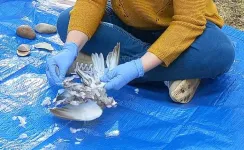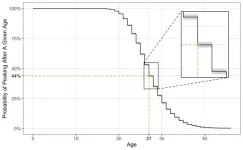(Press-News.org) NEWPORT, Ore. – Hours after tagging an endangered basking shark off the coast of Ireland in April, researchers captured what they believe is the first ever video of a shark or any large marine animal being struck by a boat.
The data, collected by an activity measurement device similar to a FitBit and a connected camera, provided scientists a unique opportunity to learn more about the impact of vessel strikes on large marine animals, which is a rising concern around the globe, said Taylor Chapple, a shark researcher at Oregon State University’s Hatfield Marine Science Center and lead author of the study.
“This is the first ever direct observation of a ship strike on any marine megafauna that we’re aware of,” Chapple said. “The shark was struck while feeding on the surface of the water and it immediately swam to the seafloor into deeper, offshore waters, a stark contrast to its behavior prior to the strike.”
“Our findings demonstrate the risk and impact of vessel strikes and the need for measures to reduce this risk.”
Researchers do not know whether the shark, a female about 7 meters long, eventually recovered from the strike. The tag was designed to release itself from the animal at a pre-determined time. About seven hours after the strike, the tag was released and later retrieved by researchers. The data showed the shark never resumed feeding or other normal behavior while it was being monitored, Chapple said.
The findings were just published in the journal Frontiers in Marine Science.
Basking sharks are the second largest known fish, frequently reaching more than 8 meters in length. They are listed as globally endangered by the International Union for Conservation of Nature, and Ireland is one of the only known locations worldwide where basking sharks continue to aggregate in large numbers.
They filter feed at the water’s surface, similar to some whales, which makes them more susceptible to boat strikes. But unlike the whales, basking sharks often sink when killed, making it hard to gauge mortality rates, said Chapple, assistant professor in the Coastal Oregon Marine Experiment Station and Department of Fisheries, Wildlife, and Conservation Sciences in OSU’s College of Agricultural Sciences.
Basking sharks in Ireland were protected under the country’s Wildlife Act in 2022. Earlier this year, the Irish government announced the establishment of the nation’s first National Marine Park, protecting 70,000 acres of land and sea on the coast of County Kerry where basking sharks frequent seasonally for feeding and potentially mating.
Shortly after the park’s establishment, the researchers were conducting a previously planned study in the park boundaries to learn more about basking shark foraging behavior and how such behavior corresponds to environmental factors. As part of their research, they tagged the basking shark with a camera and activity monitor system while it was feeding.
After following the shark at a safe distance for a few hours, the researchers departed the area for the day. The tag was designed to record autonomously until its scheduled release, at which time the researchers located it and recovered the data.
Data from the tag revealed that for several hours following the tagging and tracking, the shark spent most of its time on the surface, continuing its normal feeding behavior, with an occasional dive. Then the shark attempted to make a quick, evasive movement, which was followed by the keel of a boat cutting across its back, just behind its dorsal fin. The shark tumbled through the water and immediately increased the frequency of its tailbeat as it headed to the seafloor.
Video from the camera showed visible damage to the shark’s skin, paint marks and a red abrasion but no apparent bleeding or open wound. Vessel strikes are not always immediately lethal, but even non-lethal injuries can have short- and long-term consequences for the affected animal, the researchers noted.
“The fact that a shark we fitted our ‘Fitbit’ to was struck in this area within a few hours underlines just how vulnerable these animals are to boats and highlights the need for greater education in how to mitigate against such strikes,” said co-author Nicholas Payne, an assistant professor at Trinity College Dublin’s School of Natural Sciences. “Basking sharks filter feed at the surface, like some whales, and this behavior makes them similarly susceptible to strikes.”
The incident highlights the need for additional research on the interactions between water users and basking sharks in the National Marine Park and other hotspots along the Irish coastline, said co-author Alexandra McInturf, a research associate in Chapple’s Big Fish Lab at OSU and co-coordinator of the Irish Basking Shark Group.
“This research raises additional questions about whether and how often the sharks are actually occupying such habitats when they are not clearly visible at the surface,” McInturf said. “Given that Ireland is one of the only locations globally where basking sharks are still observed persistently, addressing such questions will be critical to informing not only our ecological understanding of the basking shark, but also the conservation of this globally endangered species.”
Additional coauthors are David Cade and Jeremy Goldbogen of the Hopkins Marine Station at Stanford University; and Nick Massett of the Irish Whale and Dolphin Group in County Kerry, Ireland.
END
Researchers record first-ever images and data of a shark experiencing a boat strike
2024-07-24
ELSE PRESS RELEASES FROM THIS DATE:
Can anxiety increase the risk of developing dementia?
2024-07-24
In a study published in the Journal of the American Geriatrics Society, both chronic and new anxiety were associated with an increased risk of dementia. However, where anxiety had resolved, there was no association with dementia risk.
The study included 2,132 individuals with an average age of 76 years who were participating in the Hunter Community Study in Australia and who were followed for an average of 10 years. The presence of chronic anxiety and new onset anxiety were associated with 2.8- and 3.2-times higher risks of having dementia, respectively. Even ...
Could Botox make walking easier in children with cerebral palsy?
2024-07-24
A recent randomized clinical trial published in Developmental Medicine & Child Neurology assessed whether injections of botulinumtoxin-A in calf muscles benefit children with cerebral palsy.
“We hypothesized that injections with botulinumtoxin-A in the calf muscles would make walking easier, caused by improved ankle joint functioning following spasticity reduction,” the authors wrote.
In the trial, one botulinumtoxin-A treatment was not superior to placebo in making walking easier (measured as a reduction in energy cost or improved walking capacity); however, there was some evidence of a delayed improvement in energy cost. Moreover, there was some evidence of a decrease ...
How is biodiversity changing in one of the world’s most productive ocean ecosystems?
2024-07-24
In research published in Global Change Biology, investigators examined DNA within ocean bottom sediment cores to assess changes in living organisms within one of the world’s most productive marine ecosystems: the Atacama Trench in the eastern Pacific Ocean, which is located about 100 miles off the coast of Peru and Chile and lies at a depth of up to 5 miles below the surface.
The study is important because ecosystems around the Atacama Trench have been intensively fished and are affected by climate change. Analyses showed a severe drop in biodiversity from 1970 to 1985 that aligns with one of the strongest known El Niño events, as well as extensive fishing efforts in the ...
How does a common skin bacterium cause chronic infections after orthopedic surgeries?
2024-07-24
In individuals who have undergone knee or hip replacement surgery, clinicians are noticing increasing numbers of chronic bone infections linked to a bacterial strain commonly found on the skin. A new study published in the Journal of Orthopaedic Research provides insights into the mechanisms involved.
Utilizing mouse models of bone infection and systematic electron microscopy studies, scientists found that the common skin bacteria Cutibacterium acnes can persist as layers of biofilms for weeks on contaminated titanium or stainless-steel implants. It can also invade ...
Have the burdens of childhood mental health conditions changed over time in England?
2024-07-24
Surveys conducted in England in 1999, 2004, and 2017 have revealed that children with a psychiatric disorder in 2017 experienced more severe difficulties and greater impacts on functioning at school, home, and in their daily lives, compared with children with a disorder in earlier decades. The findings come from a study published in the Journal of Child Psychology and Psychiatry.
The study used data from interviews and questionnaires completed by parents, children (if they were aged ≥ 11 years), and teachers across all 3 surveys.
The increased difficulties found in the study were ...
How to eliminate racial disparities in colon cancer
2024-07-24
A new paper in the Journal of the National Cancer Institute, published by Oxford University Press, finds that eliminating the race disparity in colon cancer testing in the United States would reduce colon cancer, and colon cancer death rates, dramatically among Black people.
Colorectal cancer rates and deaths from the disease have decreased over time, but racial disparities remain and are significant. Compared to White Americans, Black Americans experience higher rates of colorectal cancer incidence and lower survival rates. Black adults are approximately 23% more likely to receive a colorectal cancer diagnosis than White adults. They are also about 31% more likely to ...
Cook like a Neanderthal: Scientists try to replicate ancient butchering methods to learn how Neanderthals ate birds
2024-07-24
It's hard to know what Neanderthals ate: food preparation, especially when it comes to smaller items like birds, can leave few archaeological traces. But understanding their diets is critical to understanding these incredibly adaptable hominins, who thrived for hundreds of thousands of years in wildly varied environments. To learn what food preparation could look like in the archaeological record, scientists tried cooking like Neanderthals.
“Using a flint flake for butchering required significant precision and effort, which we had not fully valued before this experiment,” said Dr Mariana Nabais of the Institut ...
New study finds alarming rise in persistent ‘forever chemicals’ in pesticides
2024-07-24
WASHINGTON — A peer-reviewed study published today in the journal Environmental Health Perspectives has found that per- and polyfluoroalkyl substances (PFAS), known as “forever chemicals,” are increasingly being added to U.S. pesticide products, contaminating waterways and posing potential threats to human health.
The study, Forever Pesticides: A Growing Source of PFAS Contamination in the Environment, is the first-ever comprehensive review of the many ways PFAS are introduced into U.S. pesticide products. Pesticides containing PFAS are used throughout the country on staple ...
At what age do Olympic athletes peak?
2024-07-24
There’s a lot that goes into an Olympic athlete’s quest for gold – years of training and rigour – but also, an athlete’s age. A team of University of Waterloo students used statistics to figure out when an Olympic track-and-field athletes’ peak performance will be.
Track-and-field encompasses running, jumping, throwing, and combined event disciplines. Most athletes’ career performance progressions can typically be visualized as a bell curve, in which they train over several years to reach their best performance, or “peak,” at a ...
Link found between kneecap shape and debilitating joint disease
2024-07-24
The shape of a person’s kneecap could be an indicator of whether they’re more at risk of developing osteoarthritis, according to a new study from The Australian National University (ANU).
According to lead author of the study, Associate Professor Laura Wilson, women who develop knee osteoarthritis often experience more severe symptoms than men, but the reason for this is not well understood. Osteoarthritis, the most common form of arthritis, is a debilitating joint disease that causes pain, stiffness and swelling.
The research team set out to investigate whether kneecap shape might be a contributing factor.
“We wanted to focus on ...




